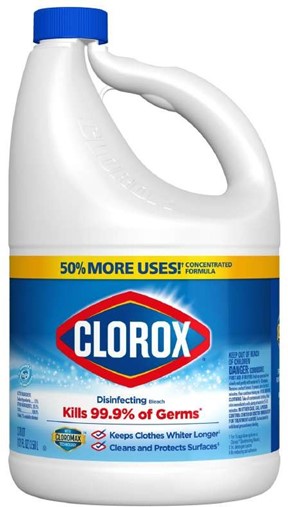A nurse at a long-term care facility is caring for a client who has AIDS. The client accidentally spills the contents of their urinal on the floor.
After cleaning up the spill with soap and water, the nurse should apply a solution of water and which of the following disinfectants to the floor?
Isopropyl alcohol.
Chlorhexidine.
Hydrogen peroxide.
Bleach.
The Correct Answer is D
Bleach.

According to the CDC, bleach is an effective disinfectant for environmental surfaces contaminated with blood or body fluids from a person with AIDS or other bloodborne pathogens. Bleach can kill HIV and hepatitis viruses when used in a 1:10 dilution with water.
Choice A is wrong because isopropyl alcohol is not recommended for disinfecting environmental surfaces. It can evaporate quickly and may not have enough contact time to kill the pathogens.
Choice B is wrong because chlorhexidine is an antiseptic, not a disinfectant. It is used for skin cleansing or wound irrigation, but it is not effective against spores or non-enveloped viruses.
Choice C is wrong because hydrogen peroxide is a low-level disinfectant that can be inactivated by organic matter.
It is not suitable for disinfecting surfaces contaminated with blood or body fluids.
Nursing Test Bank
Naxlex Comprehensive Predictor Exams
Related Questions
Correct Answer is ["A","C"]
Explanation
Choice A reason:
The Bradley method teaches the labor partner how to coach and support the mother during labor. This is true because the Bradley method emphasizes the role of the partner as an active participant and a skilled coach who can help the mother relax, breathe, and cope with pain during labor. The partner also serves as an advocate for the mother's preferences and needs in the hospital setting.
Choice B reason:
The Bradley method teaches the mother and partner about the variety of methods to control pain. This is false because the Bradley method does not teach a variety of methods to control pain, but rather focuses on relaxation as the main way to reduce pain during labor. The Bradley method also discourages the use of medication or medical interventions for pain relief, unless they are medically necessary.
Choice C reason:
The Bradley method prepares the woman to deliver without medical interventions and medications. This is true because the Bradley method aims to help women have an unmedicated birth with minimal medical intervention. The Bradley method teaches women how to avoid unnecessary interventions and how to cope with natural labor by using relaxation, breathing, nutrition, and exercise. The Bradley method also educates women on how to reduce their risk of having a C-section and what to do if it becomes medically necessary.
Choice D reason:
The Bradley method focuses on muscle control because muscle tension increases the pain of labor. This is false because the Bradley method does not focus on muscle control, but rather on deep and complete relaxation during labor. The Bradley method believes that muscle tension interferes with the natural process of labor and increases pain, so it teaches women how to relax their muscles and let their bodies do the work.
Choice E reason:
The Bradley method is the most widely used method in the US. This is false because the Bradley method is not the most widely used method in the US, but rather one of several options for natural childbirth. According to a 2017 survey by Listening to Mothers, only 4% of women reported using the Bradley method for their most recent birth, compared to 48% who used Lamaze, 14% who used hypnobirthing, and 9% who used other methods.
Correct Answer is B
Explanation
Ask the client to empty their bladder.

This is because a full bladder can interfere with the pelvic examination and cause discomfort to the client. The nurse should also instruct the client to avoid douching, using tampons, vaginal medications, sprays, powders, birth control foam, cream, or jelly for at least 24 hours before the exam.
Choice A is wrong because the client should be placed in a lithotomy position, not a prone position, for a pelvic examination.
Choice C is wrong because douching can alter the normal vaginal flora and pH, and increase the risk of infection.
Choice D is wrong because placing the client’s arms over their head can tighten the abdominal muscles and make the examination more difficult. The nurse should ask the client to place their arms at their sides or across their chest.
Whether you are a student looking to ace your exams or a practicing nurse seeking to enhance your expertise , our nursing education contents will empower you with the confidence and competence to make a difference in the lives of patients and become a respected leader in the healthcare field.
Visit Naxlex, invest in your future and unlock endless possibilities with our unparalleled nursing education contents today
Report Wrong Answer on the Current Question
Do you disagree with the answer? If yes, what is your expected answer? Explain.
Kindly be descriptive with the issue you are facing.
